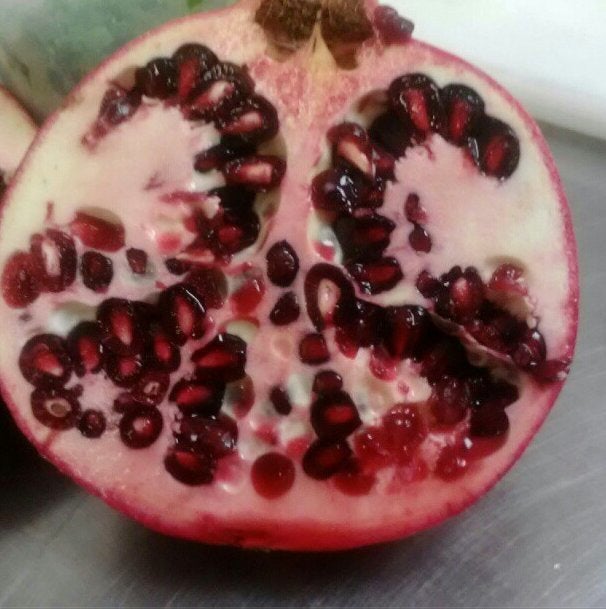
Pomegranate season in California means a several things to me: 1. my parents will get a box of the heavy red orbs for Christmas as per a 50-plus year family tradition; 2. My 3-year-old's face will look like a horrific dental accident on a regular basis; and 3. It's another reminder that for a picky kid, sometimes it just takes one cool friend to turn you onto a new food.
In third grade, everyone wanted to be Angela's best friend. She was smart and sweet with heavy blonde hair and slightly sleepy blue eyes that washed into green when she cried. Angela didn't try to be popular or a trendsetter and yet, popular trends exploded in her quiet wake. She was cool.
When Angela wore the first pair of string barrettes Jefferson Elementary had ever seen, I spent an entire day yearning after those satiny streams of lavender and pink and then went home and wheedled my mother into making them. In the months that followed, bright ribbons rippled from every elementary school girl's fair brow. When Angela wore a never-before-seen "powder jacket" with light blue sleeves and a dark blue body, I wasn't the only one to wrangle one in green and blue.
But Angela didn't just affect our ensembles, she also changed the way we ate.
And why? SCIENCE! See, according to a 2008 article published in the scientific journal Appetite, children have enormous influence over one another. (Yes, this is sort of a "duh" to all of us who have experienced peer pressure, but it was a lightbulb moment for me when I realized the scientists were talking about it specifically in relation to picky eaters overcoming the fear of trying new foods.) Regarding picky eating the article notes, "...during childhood the social importance of others in decreasing food neophobia switches from the caregivers and siblings to friendship circles and individuals perceived to be more socially important for modeling acceptable behavior."
In other words, if you have a cool friend and that cool friend brings some weird food to lunch and likes it, you'll probably want to try it.
Examples from my picky real life: Angela brought a crazy white peelable stick in her lunch and BOOM! String cheese was all the rage among the Dictopedia set. She pulled out a shiny, silver, space suit of a drink box, and we were all begging our parents to buy Capri Suns, the harlot of the lunchbox. Finally, on that fateful day when Angela cracked open her plastic Smurf lunchbox to reveal an awkward piece of fruit with tough, bumpy skin and showed us how you eat only the ruby seeds, the pomegranate was an instant sensation.
In the weeks that followed, pomegranates bloomed in everyone's lunches and were so adored that kids actually tried to swap for them. A FRUIT was swappable!
As most food fads prove, herd mentality runs deep in the young, so even if kids don't fall in with the newest, strangest food just because the most popular girl in class spearheaded it, chances are they get dragged along in the ensuing fad. Just check out what the scientists in the Appetite article have to say about that: "the more the people around the child consuming the novel food, the more willing the child will be to try it... This would suggest that a young child learns to accept foods through observing significant others, rather than linguistic reasoning."
Beverly Cleary shrewdly illustrates the power of food fads in Ramona Quimby, Age 8. Ramona, who admits she doesn't even like hardboiled eggs, doesn't want to be left out of the newest fad at school, so she brings them in her lunch and made herself eat them until that fateful day when she mistakenly cracked a raw one in her hair.
With my limited influence, I managed to engineer a food fad only once. It was when I invented "onion cheese," which, like all great discoveries, came to me quite by mistake. I had sliced up some purple onions for something and then, without cleaning the knife, immediately cut some pieces of cheddar for my lunch. The next day at school, I noticed a faint but unmistakable scent of onion on my cheese pieces, and once I figured out who I had engineered it, I went out of my way to duplicate the phenomenon. With no intention of using the pieces, I'd carelessly hack up an onion just to transfer the oils from the knife to the cheese.
It became such a hit at the fifth grade lunch table that while some friends copied me, another even tried to improve on my original invention by adding big chunks of onion to her baggie of cheese. (Between you and me? It was overkill. Only the delicate hint of onion was needed to make Onion Cheese, otherwise, you were just eating onions. And cheese. Anyone can do that!)
Now as with every picky eating "fix," I present here and in Suffering Succotash, I'm not saying that cool kids or herd mentality are the answer to every picky eating problem in the young ones -- and neither is blaming the parents, by the way -- I'm saying that they can work at certain ages. At three, my son is too young for me to figure out which "cool kids" around him might influence his eating. However, I have noticed that he has a "grass is always greener" sort of reaction to his friend's food. Even when I bring all of his favorite things to a picnic or a playdate, he's far more interested in whatever other mother brought for her kids.
Unless, of course, I happen to bring pomegranates.